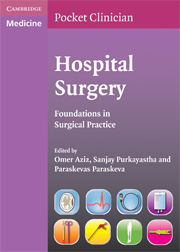Book contents
- Frontmatter
- Contents
- List of contributors
- Foreword by Professor Lord Ara Darzi KBE
- Preface
- Section 1 Perioperative care
- Section 2 Surgical emergencies
- Section 3 Surgical disease
- Hernias
- Dysphagia: gastro-oesophageal reflux disease (GORD)
- Dysphagia: oesophageal neoplasia
- Dysphagia: oesophageal dysmotility syndromes
- Gastric disease: peptic ulcer disease (PUD)
- Gastric disease: gastric neoplasia
- Hepatobiliary disease: jaundice
- Hepatobiliary disease: gallstones and biliary colic
- Hepatobiliary disease: pancreatic cancer
- Hepatobiliary disease: liver tumours
- The spleen
- Inflammatory bowel disease: Crohn's disease
- Inflammatory bowel disease: ulcerative colitis
- Inflammatory bowel disease: infective colitis
- Inflammatory bowel disease: non-infective colitis
- Colorectal disease: colorectal cancer
- Colorectal disease: colonic diverticular disease
- Perianal: haemorrhoids
- Perianal: anorectal abscesses and fistula in ano
- Perianal: pilonidal sinus and hidradenitis suppurativa
- Perianal: anal fissure
- Chronic limb ischaemia
- Abdominal aortic aneurysms
- Diabetic foot
- Carotid disease
- Raynaud's syndrome
- Varicose veins
- General aspects of breast disease
- Benign breast disease
- Breast cancer
- The thyroid gland
- Parathyroid
- Adrenal pathology
- Multiple endocrine neoplasia (MEN)
- Obstructive urological symptoms
- Testicular lumps and swellings
- Haematuria
- Brain tumours
- Hydrocephalus
- Spinal cord injury
- Superficial swellings and skin lesions
- Section 4 Surgical oncology
- Section 5 Practical procedures, investigations and operations
- Section 6 Radiology
- Section 7 Clinical examination
- Appendices
- Index
General aspects of breast disease
Published online by Cambridge University Press: 06 July 2010
- Frontmatter
- Contents
- List of contributors
- Foreword by Professor Lord Ara Darzi KBE
- Preface
- Section 1 Perioperative care
- Section 2 Surgical emergencies
- Section 3 Surgical disease
- Hernias
- Dysphagia: gastro-oesophageal reflux disease (GORD)
- Dysphagia: oesophageal neoplasia
- Dysphagia: oesophageal dysmotility syndromes
- Gastric disease: peptic ulcer disease (PUD)
- Gastric disease: gastric neoplasia
- Hepatobiliary disease: jaundice
- Hepatobiliary disease: gallstones and biliary colic
- Hepatobiliary disease: pancreatic cancer
- Hepatobiliary disease: liver tumours
- The spleen
- Inflammatory bowel disease: Crohn's disease
- Inflammatory bowel disease: ulcerative colitis
- Inflammatory bowel disease: infective colitis
- Inflammatory bowel disease: non-infective colitis
- Colorectal disease: colorectal cancer
- Colorectal disease: colonic diverticular disease
- Perianal: haemorrhoids
- Perianal: anorectal abscesses and fistula in ano
- Perianal: pilonidal sinus and hidradenitis suppurativa
- Perianal: anal fissure
- Chronic limb ischaemia
- Abdominal aortic aneurysms
- Diabetic foot
- Carotid disease
- Raynaud's syndrome
- Varicose veins
- General aspects of breast disease
- Benign breast disease
- Breast cancer
- The thyroid gland
- Parathyroid
- Adrenal pathology
- Multiple endocrine neoplasia (MEN)
- Obstructive urological symptoms
- Testicular lumps and swellings
- Haematuria
- Brain tumours
- Hydrocephalus
- Spinal cord injury
- Superficial swellings and skin lesions
- Section 4 Surgical oncology
- Section 5 Practical procedures, investigations and operations
- Section 6 Radiology
- Section 7 Clinical examination
- Appendices
- Index
Summary
History
The history from the patient is essential in helping you to establish the causes of disease and assessing whether there is an increased risk of malignancy. The history should be taken in a private place and it should be done with sympathy, as most breast patients are very anxious. This should cover:
Age of the patient: this is very important. Remember, cancers are uncommon below the age of thirty.
Lump: always ask about: the length of time it has been present. Its relation to the menstrual cycle. Exact location (note which breast). Does its size vary? Is it getting larger?
Pain: is the lump painful? Is this cyclical?
Nipple discharge: ascertain colour, quantity, pattern, frequency.
Skin changes of the breast/nipple.
Shape of breast: ask if she has noticed any nipple retraction, breast distortion.
Metastatic related symptoms: e.g. back pain, shortness of breath, jaundice.
Previous breast disease, and whether this was investigated/treated.
Family history: this is extremely important, and many clinics offer family counselling and screening.
Other risk factors for breast cancer (see Breast cancer Chapter).
Genetics of breast cancer: 5–10% of breast cancers are inherited in a dominant fashion. They are of an early onset and are associated with other tumours e.g. bowel, ovarian. The following genes have been isolated: BRCA1 (chromosome 17q21), BRCA2 (chromosome 13q24), P53 gene on chromosome 17p (associated with Li-Fraumeni syndrome).
Medication: HRT, OCP.
Gynaecological/obstetric history: all these symptoms should be related to the woman's normal cycle.
- Type
- Chapter
- Information
- Hospital SurgeryFoundations in Surgical Practice, pp. 482 - 485Publisher: Cambridge University PressPrint publication year: 2009

